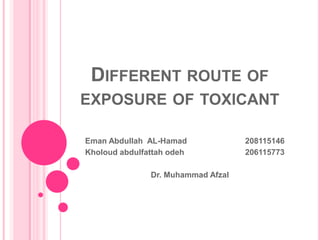
Different route of exposure of toxicant
- 1. DIFFERENT ROUTE OF EXPOSURE OF TOXICANT
- 2. HOW CHEMICALS ENTER THE BODY IS DEPENDENT ON THE PROPERTIES OF THE CHEMICAL AND THE BIOLOGY OF THE ORGANISM.
- 3. There are four primary routes of exposure to chemical contaminants; Injection Ingestion Topical Inhalation
- 4. INJECTION It’s the only route in which the entire amount exposed is absorbed regardless of the chemical administered, because the chemical is introduced directly into the body. Chemicals may be injected intravenously (directly into a vein), intramuscularly (into a muscle), subcutaneously (under the skin), intraperitoneally (within the membrane lining the organs of the abdomen).
- 5. Because the blood is the vehicle of chemical distribution in the body, intravenous injection is the most rapid method of introducing a chemical into the body. The almost instantaneous distribution, together with the irreversibility, makes intravenous injection a dangerous method of chemical exposure, with a fair chance of causing drug overdose if improperly administered.
- 6. INGESTION is the most common route of exposure to toxic chemicals. Most chemicals diffuse across the cell membrane in the non-ionized form, so that the degree to which the chemical is ionized is important in determining whether a chemical is absorbed. Organic acids and bases dissociate into their ionized forms in response to the pH conditions of the environment. Organic acids are in their non- ionized form in an acidic environment (such as the stomach), and they thus tend to diffuse across a membrane, whereas organic bases are non-ionized and thus diffuse across a membrane in a basic environment (such as in the intestine).
- 7. The pH on the mucosal surface of the small intestine is alkaline. Organic bases tend to be in the non-ionized, lipid-soluble form and thus in general are absorbed there. The pH of the stomach contents is in the range of 1 to 2 (strongly acidic), and weak organic acids tend to be in the non-ionized, lipid-soluble form. It might be expected that the poisons would be absorbed there, but, because the surface area of the stomach is much smaller than that of the small intestine, often the stomach contents (along with the poisons) are passed to the intestine before the chemicals are absorbed. The acidic environment of the stomach is the main reason for the poor absorption of organic basesy the stomach.
- 8. TOPICAL EXPOSURE Ithappens in Skin Skin is consists of two parts, Epidermis and Dermis.
- 9. TOPICAL EXPOSURE Epidermis has Stratum corneum Dermis Connective tissues, elastin fibres, sweat glands, hair follicles, cappilaries
- 10. TOPICAL EXPOSURE The absorption is directly proportional with the lipid solubility. The absorption is inversely proportional to the Mw.
- 11. FACTORS AFFECT THE RATE OF ABSORBTION: 1. The thickness of the layer. 2. The condition. 3. The dryness. 4. The state of the molecules
- 12. INHALATION For Gases In Lungs Gas molecules move into the blood by partitioning
- 13. INHALATION For aerosols particle size and water solubility. Aerosols of less than 100 micrometres
- 14. INHALATION The larger aerosols (greater than five micrometres) tend to be deposited in the upper respiratory tract, while the smaller ones (less than five micrometres) have a greater chance of being deposited on deeper sites of the lung
Hinweis der Redaktion
- For the topical exposure, the skin is the main part that is specialized in it As we know, The skin is consist of two parts the dermis and the epidermis The outer layer of the Epidermis (consist of 5 layers) is Stratum corneum that consists of dead cells and is the major barrier to chemical transfer through the skin.Non-polar chemicals cross the skin by diffusion through the stratum corneum, no active transport exists in the dead cells of this layer.
- Contains Connective tissues of collagen and elastinfibres,sweat glands, hair follicles,cappilariesAfter crossing the epidermis, chemical molecules are absorbed into the circulatory system via the capillaries.
- Stratum corneum is not permeable to the water soluble molecules.But it is permeable to the lipid soluble molecules.
- The rate of percutaneous absorption also varies with the thickness of the stratum corneumThe rate is high in skin of foreheadaxilla and abdominThan the thicker regions like the palm.Solids can not be absorbed, no pinocytosisperations in the dead cellsGases can absorbed through the skin but not as much as inhalation.
- Absorbtion of gases take place in lungs but before reaching the lungs it will pass the nose (mucosa) process between two phases, from a phase of high partial pressure to an adjacent phase of low partial pressure.
- it must be inhaled and deposited on the respiratory tract
